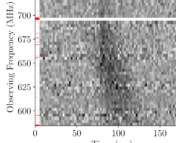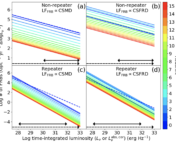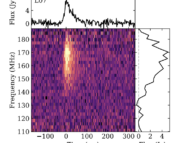The Undergraduate Research series is where we feature the research that you’re doing. If you are an undergraduate that took part in an REU or similar astro research project and would like to share this on Astrobites, please check out our submission page for more details. We would also love to hear about your more general research experience!
Yuliya Shpunarska
McGill University
Yuliya Shpunarska is an undergraduate studying Physics at McGill University. She completed this research in the CHIME/FRB collaboration through the McGill Space Institute undergraduate research program, under the supervision of Dr. Vicky Kaspi and Dr. Daniele Michili.

Fast radio bursts (FRBs) are somewhat of a space oddity: they’re radio transients of unknown origin, detected in other galaxies. Some of them repeat, some do not. Most importantly, they can output as much energy in a few milliseconds as the Sun does in several days. My project aims to precisely measure the flux and the fluence, two quantities related to the light output of these events, using data from the CHIME (Canadian Hydrogen Mapping Experiment) telescope. The flux is the power of the light caught by the telescope when the peak is at its brightest, whereas the fluence is the integral of the burst’s flux over time, and it has to do with the total energy of the burst.
The CHIME radio telescope, which is sensitive at frequencies between 400 and 800 MHz, is exceptional for detecting these short and powerful pulses thanks to its large field of view and its unusual geometry. However, measuring the flux of events with this setup is difficult due to the highly uneven sensitivity of the telescope in the N-S and E-W directions. Our current estimates only yield a lower limit for the flux, since they only use a portion of the available data, so I developed software that uses the full range of data offered by CHIME (so-called “baseband data,” which has a higher resolution and can be used to virtually “point” the telescope in a specific direction). By also using a precise model for the sensitivity of the telescope at different positions in the sky, this analysis method will dramatically improve the precision of the flux measured for hundreds of detected FRBs. In particular, for the second CHIME/FRB catalogue (the first can be found here), which is scheduled to be published in the coming years. This will be a first for such a large and uniform sample of these events.
In the future, with the building of several CHIME “outrigger” telescopes around North America that will allow for better distance estimates of FRBs, this work sets the basis for measuring the luminosity of all FRBs detected in this experiment. These new precise measurements will help constrain the FRB sources’ physical properties and provide invaluable information on their elusive origin.
Astrobite edited by: Haley Wahl
Featured image credit: The CHIME Collaboration




